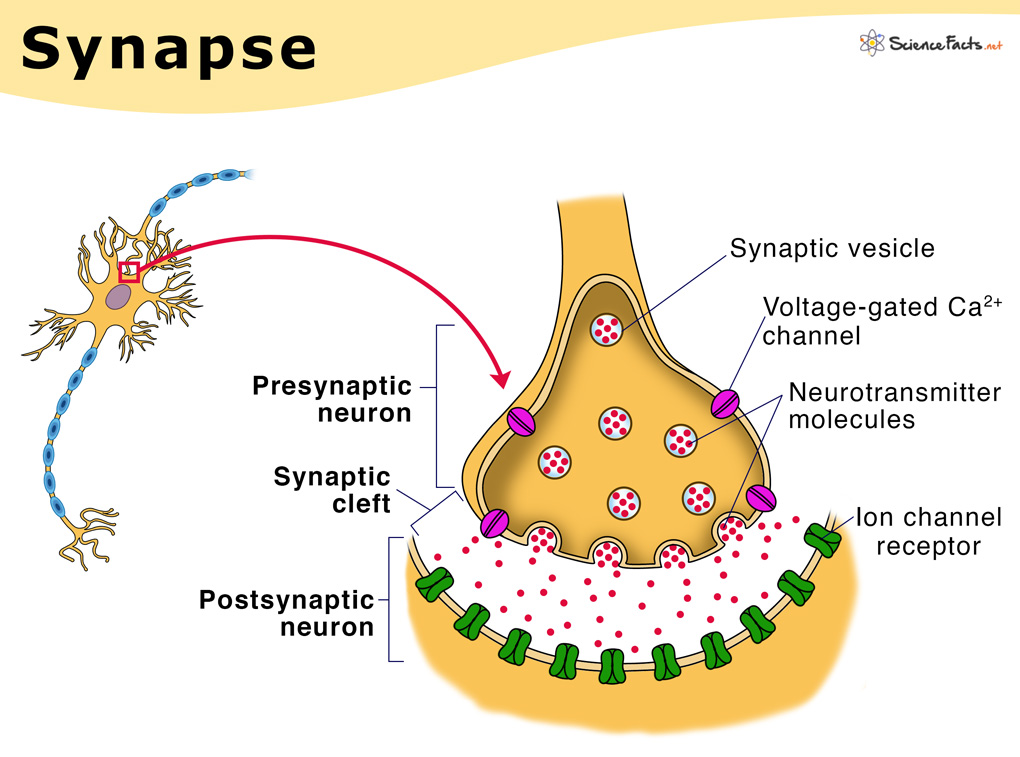Synapse
What is a Synapse
Synapse is a junction with a minute gap that separates two neurons (nerve cells), the basic unit of the nervous system in the brain. They are also found between a neuron and a muscle cell or gland. An adult human brain roughly has 1,000 to 5,000 trillion synapses.
The term ‘synapse’ was first coined by Charles Sherrington in 1897, from the Greek words ‘syn’, which means ‘together’ and ‘haptein’ meaning ‘to clasp’.
Location
The functions of synapses depend on where they are found. The three forms based on their location are: axodendritic – axon of one neuron and the dendrite of the next adjacent neuron. This is the most common form of synapse that dominates the nervous system; axosomatic – axon of one neuron and the cell body of the other neuron; axoaxonic – between two axons.
Structure
Size
Synapses can vary widely in size and shape. They are too small to be viewed under a light microscope, measuring approximately 20-40 nm wide.
Parts
Synapses are composed of three main parts:
- Presynaptic neuron: Contains the terminal button having neurotransmitters within the synaptic vesicles
- Postsynaptic neuron: Composed of a part of the dendrite or cell body of the neuron, and contains receptor sites to receive incoming signals from the presynaptic cell
- Synaptic cleft: The gap between the pre- and postsynaptic neurons
What Happens at the Synapse
Conduction of nerve impulses in the body is a one-way process where each neuron has a neurotransmitter (e.g. acetylcholine, adenosine, or norepinephrine) that is released into the synaptic cleft, while the adjacent neuron has the receptor to bind the neurotransmitter. Whether a neurotransmitter promotes or inhibits the generation of signal depends on the receptor it binds.
Types
Synapses are fundamentally classified into two different types based on how the neurons function to communicate: 1) chemical synapse and 2) electrical synapse.
1) Chemical Synapse
Found in vertebrates, it works using neurotransmitters that establish the virtual connection between the presynaptic and postsynaptic neurons.
The arrival of the signal in the presynaptic neuron triggers the release of neurotransmitters, which then diffuses across the synaptic cleft. This step occurs in the presence of calcium ions, where the fusion of the synaptic vesicle with the axon terminal membrane of the presynaptic neuron allows the release of the neurotransmitter into the synaptic cleft. The binding of the neurotransmitter to the receptor of the postsynaptic neuron excites the postsynaptic neuron to carry forward the signal.
2) Electrical Synapse
Mostly found in invertebrates and lower vertebrates, they form direct physical connections between the presynaptic and postsynaptic neurons. This connection takes the form of a channel called a gap junction, which allows ions to flow directly from one cell into another.
FAQs
Ans. Caffeine affects the transmission of the nerve impulse by blocking the activity of adenosine, a neurotransmitter that affects almost every animal system.
Ans. Drugs affect synapses by interfering with the way neurons send, receive, and process signals using neurotransmitters. Some drugs, such as marijuana and heroin, can activate neurons because their chemical structure mimics that of a natural neurotransmitter in the body and thus functions similarly to acetylcholine or adenosine.
Ans. Alcohol alters the neuronal functions by disrupting communication at the synapses. It also inhibits the generation of new electrical impulses.
Ans. A chemical synapse is a small gap of about 3.5 nm between the two neurons, which transmit information utilizing chemicals called neurotransmitters. In contrast, an electrical synapse is a gap of 20 nm that has channel proteins connecting the two neurons. Electrical synapses transfer signals much faster than chemical synapses. While the speed of transmission in chemical synapses can take up to several milliseconds, the transmission at electrical synapses is nearly instantaneous.
-
References
Article was last reviewed on Friday, June 18, 2021




